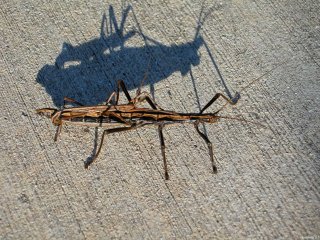Last year I ran across a pair of walking sticks (Anisomorpha buprestoides) during an afternoon stroll at Yamato Scrub. They were in such a visually striking pose that I had to stop and take a picture, and then read what I could find about them on the web. And it made for some interesting reading.
Since then, though, I’ve been doing more reading, and at a more leisurely pace. One of my favorite reads came from the shelves of the Broward county library: Thomas Eisner’s For Love of Insects, which I checked out over the summer and promptly devoured. Since then, thoughts of walking sticks hadn’t really crossed my mind, although on one of my evening rides with the boy, we saw several pairs of these creatures crossing the bike path of the El Rio Canal, from a scrubby vacant lot headed to the grass bordering the canal. I wish I’d had time to stop and watch them, but the sun was sinking and the boy doesn’t watch himself, so I have to… Off we went, accompanied by the sound of my mental sighs.
Then, earlier this week, when I was in Manhattan after a hastily arranged business meeting, I found a copy of Thomas Eisner’s book at the Strand, and it practically leapt off the shelf into my shopping bag. As I reread it, I wondered at how I could have ever forgotten that Eisner’s favorite place on Earth appears to be Florida Scrub! I guess I was too busy trying to absorb the chemistry and entomology of the book, neither of which is particularly demanding. (If you haven’t read this book, you should; it reads almost like a memoir, and it presents a decidedly difficult-to-love group of animals in a singularly appealing style.)
One of the first anecdotes Eisner tells about his entomology expeditions at Archbold Biological Station is about the walking stick, also known as devil’s rider, A. buprestoides. These strange creatures have some unusual behaviors. For example, they discharge a potent defensive chemical when handled roughly by humans; they even appear to aim it toward the eyes.
What’s more, these insects that defend themselves only after being handled roughly by humans actually change strategies when confronted by potential predators like Cyanocitta cristata, our familiar eastern Blue Jay. Instead of waiting for the insult, as they do with us humans, the insects spray preemptively when confronted by birds! In other words, somehow these little creatures can discriminate nicely between the threat posed by humans and that posed by potential predators, and they don’t let the potential predators come close to them. According to Eisner,
I never figured out what it is about a bird that makes it recognizable as such to the walkingstick. It is clear that no crude combination of vibrational and visual cues is involved. I tried to elicit discharges by waving objects in the vicinity of walkingsticks, or by tapping the substrate around them, but without success. Anisomorpha evidently is programmed not to waste its secretion, and to fire only on “the real thing.” (86)
Now that is something unusual in the world.
The chemical, a terpene, is actually synthesized inside the insect’s body, rather than being incorporated into it ready-made from its larval diet, as with the milkweed caterpillars (Danaus, Limenitis, etc.). At the time of Eisner’s research, the question of whether or not insects could manufacture their own chemicals, or whether they had to acquire them ready-made, had not yet been answered, so this was important confirmation of insects’ chemical manufacturing prowess.

